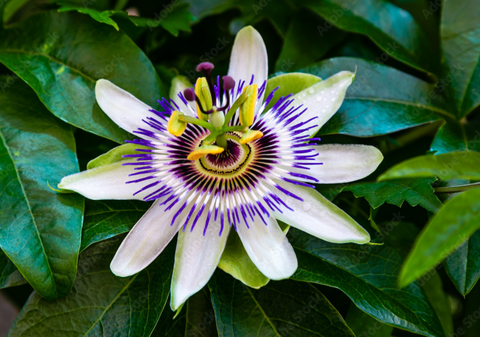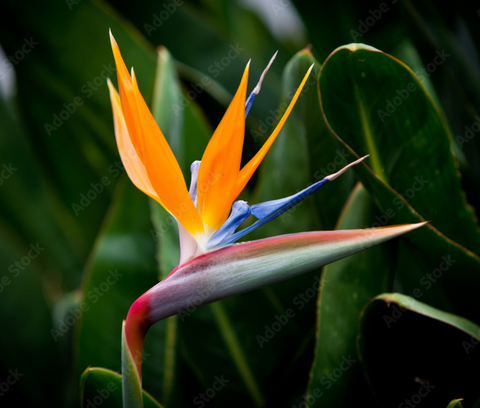Passionflower (Passiflora) is a climbing plant that can be grown in a container at home. It thrives in bright places, but not in direct sunlight. It needs well-drained soil and regular watering, but it does not tolerate too much moisture, so good drainage is essential. Passionflower is sensitive to cold, so we keep it indoors in the winter. With proper care, it can produce edible fruits rich in vitamins. It is recommended to place the pot near a support because the plant grows quickly and climbs. Watch out for pests such as mites that can damage the leaves.
🌿 Cultivation of passion fruit or passion fruit
Growing this plant is relatively easy because it is a hardy plant that climbs quickly. Passionflower needs a warm, sunny location protected from strong winds. It grows best in humus-rich, well-drained soil. The plant likes regular watering, but the soil must be slightly dry between waterings because it does not tolerate standing water.
It is important to provide the plant with support, as it is a climber. It is often pruned to encourage denser growth and more flowering. With proper care, a flowering passion fruit can produce edible fruits – passion fruit. It overwinters indoors or protected from the cold because it cannot tolerate low temperatures. We also watch out for pests such as aphids and mites.
🌿 Plant fertilization
Regular fertilization with potassium-rich fertilizer is also important for successful cultivation, as it stimulates flowering and fruit growth.
🌿 Planting a plant
The process of planting passion fruit is simple, but it requires some attention to ensure optimal growing conditions. Here is the basic procedure:
1. Choosing a pot: Choose a pot that is large enough, at least 30 cm in diameter, with drainage holes at the bottom. Passionflower needs space for its roots and good drainage.
2. Soil preparation: Use a quality potting mix that is rich in nutrients and has good drainage. It is recommended to add perlite or sand to improve drainage.
3. Planting: Fill the pot with some soil and place the passion fruit seedling in it. Gently spread the roots and cover them with soil. Make sure the plant is planted at the same depth it was in the pot before planting.
4. Watering: After planting, water the plant well so that the soil sticks around the roots. Make sure that the water drains out of the pot to prevent water stagnation.
5. Setting up a support: Since passionflower is a climber, immediately after planting, set up a support such as a net or pole for it to climb.
6. Location: Place the container in a bright and warm place, but not in direct sunlight, so that the young plant does not burn.
After planting, water the plant regularly, but make sure the soil is not too wet.
🌿 Exotic and unique passionflower flowers
The first thing that attracts attention about passionflower are its flowers, which are considered to be among the most beautiful in the plant world. Their structure is complex, full of symmetry and unusual color combinations. Passionflower flowers have five petals, five sepals, and in the center rise unusual growths that are crucial for pollination. This unique structure of the flowers has already fascinated researchers and naturalists, who have associated the flowers with religious symbolism, especially with the Passion of Christ, which is why the plant got its name.
Passionflower blooms from spring to late autumn, depending on the species and growing conditions. Its flowers are open for only a few days, but due to the rapid succession of flowers on the plant, new ones are constantly appearing. Among the most common flower colors are white, purple, blue and red, which allows for a variety of uses in ornamental gardens.
🌿 Medicinal properties of passion fruit
In addition to its stunning appearance, passion fruit is considered an extremely medicinal plant. Its leaves, flowers, and fruits contain various medicinal substances that have been traditionally used to treat various diseases. Especially in herbalism and alternative medicine, passion flower is valued for its soothing properties.
The main active ingredient in passion fruit is a flavonoid called chrysin, which acts as a natural sedative. A tea or tincture made from the leaves and flowers of passion fruit is often used to relieve anxiety, stress, and insomnia. It also helps relieve symptoms of depression, hypertension, and digestive problems. Because of its beneficial effects on the nervous system, many people use it as a natural alternative to synthetic medications for anxiety and insomnia.
Passionflower is also known for its pain-relieving and anti-inflammatory properties. It contains alkaloids that help relax muscle spasms, making it useful for headaches, menstrual cramps, and joint pain. In addition, its fruits are rich in vitamin C, which contributes to the overall strengthening of the immune system.
🌿 Passion fruit
One of the main reasons passion fruit is popular among gardeners is its delicious and nutritious fruit, known as passion fruit (Passiflora edulis). These oval fruits have a hard skin that hides a juicy, slightly acidic pulp full of tiny seeds. Passion fruit is rich in vitamins A, C and fiber, and also contains important minerals such as potassium, magnesium and iron.
Passion fruit is very versatile, as it can be eaten fresh, added to salads, yogurts, smoothies or desserts. It is also often used to make juices, syrups and sauces, which gives it an important culinary value. In addition, it has many health benefits, as it helps improve digestion, strengthens the immune system and contributes to better hydration of the body.

🌿 Where can we plant passion fruit?
Passionflower is an extremely adaptable plant that can be planted in a number of different locations, depending on your gardening goals and conditions:
- In the garden: Passionflower is an excellent choice for gardens where you want to create a lush, blooming scene. It is ideal for covering fences, walls or pergolas, where it can climb freely and create pleasant shade. Due to its fast-growing nature, passionflower can cover an entire area within a few years, which is great for creating natural privacy.
- On a terrace or balcony: Passionflower also grows well in pots or larger containers, making it suitable for terraces and balconies. It is important to choose a large enough container and provide support for the plant to climb on. If you live in a colder climate, you can bring it indoors or into a greenhouse during the winter.
- Indoors or in a greenhouse: Passionflower can also be successfully grown indoors or in a greenhouse, especially if you have enough light. Although it may bloom less intensely in these conditions, it will still add a touch of exoticism to your home or greenhouse.
Whether you choose to grow passion fruit for its beautiful flowers, edible fruit, or soothing properties, this plant is definitely worth your attention. With proper care, proper planting, and love, passion fruit will flourish and thrive, providing you with aesthetic pleasure and health benefits. Let passion fruit be the next plant you add to your green corner!



